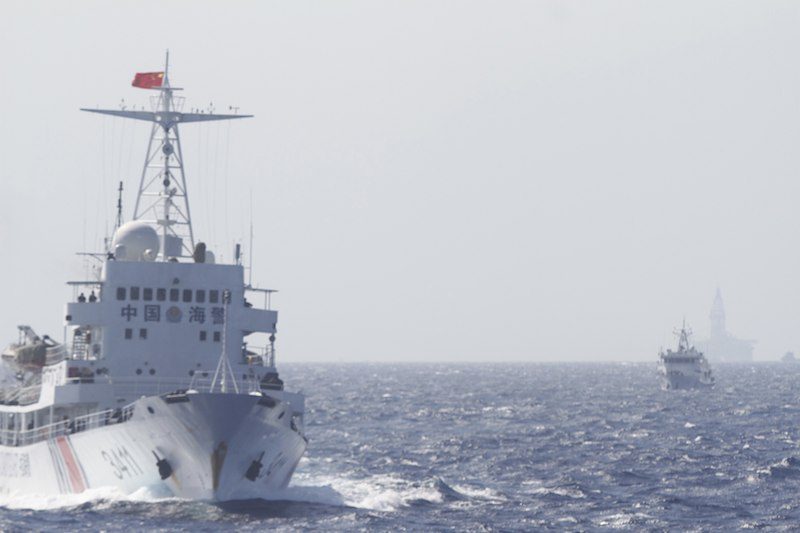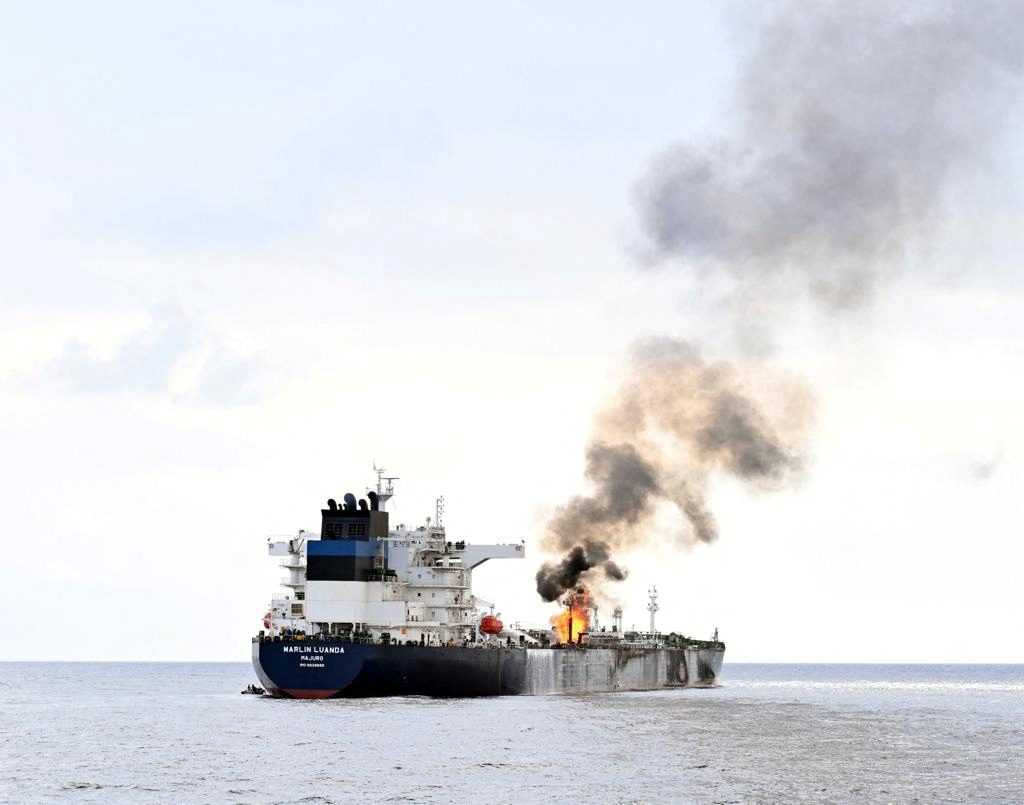Chinese Coast Guard ships are seen near Chinese oil rig Haiyang Shi You 981 in the South China Sea, about 210 km (130 miles) off shore of Vietnam May 14, 2014. REUTERS/Nguyen Minh
By David Tweed
July 3 (Bloomberg) — Admiral Zheng He is everywhere in China these days, even though he died almost 600 years ago. The government is promoting him to remind its people — and Asia — that China’s destiny is to be a great naval power.
Almost a century before Christopher Columbus discovered America, Zheng in 1405 embarked on a series of voyages with ships of unrivaled size and technical prowess, reaching as far as India and Africa.
The expeditions are in the spotlight in official comments and state media as China lays claim to about 90 percent of the South China Sea and President Xi Jinping seeks to revive China’s maritime pride. In doing so he risks setting up confrontations with Southeast Asian neighbors and the U.S., whose navy has patrolled the region since World War II. Geopolitical dominance of the South China Sea would give China control of one of the world’s most economically and politically strategic areas.
“The Chinese believe they have the right to be a great power,” said Richard Bitzinger, a senior fellow at the S. Rajaratnam School of International Studies in Singapore. “What we are seeing is a hardening of China’s stance about its place in the world.”
Stretching from Taiwan toward Singapore, about half of the world’s merchant tonnage flows through the region, carrying about $5.3 trillion of goods each year, from iron ore and oil to computers and children’s toys. Some 13 million barrels of oil a day transited the Straits of Malacca in 2011, about one third of global oil shipments. The sea lanes currently lack a dominant overseer, with the U.S., China and neighboring nations all having a presence.
Overlapping Claims
China’s claim is based on a 1947 map, with a more recent version following a line of nine dashes shaped like a cow’s tongue, looping down to a point about 1,800 kilometers (1,119 miles) south from the coast of Hainan island. The area overlaps claims from Vietnam, Malaysia, the Philippines, Brunei and Taiwan. In the adjacent East China Sea, China contests islands administered by Japan.
The ambitions of China’s leaders don’t stop at the nine- dash line.
“China’s ultimate long-term goal is to obtain parity with U.S. naval capacity in the Pacific,” said Willy Wo-Lap Lam, adjunct professor at the Centre for China Studies at the Chinese University of Hong Kong. “This is a long-term proposition. At this stage the Chinese understand they don’t have the capacity to take on the U.S. head-on.”
‘Chinese DNA’
Sensing the U.S. is distracted by foreign policy challenges in the Middle East and Ukraine, China has been ratcheting up pressure on its neighbors, Lam said. It seized control of the Scarborough Shoal from the Philippines in 2012 as Chinese ships “shooed away” their rivals.
China in early May towed a $1 billion oil exploration rig into contested waters near the Paracel Islands off Vietnam, sparking skirmishes between coast guard vessels, the sinking of a Vietnamese fishing boat and anti-Chinese demonstrations. In an attempt to soothe tensions, Premier Li Keqiang said June 18 that “expansion is not in the Chinese DNA” and that talks can ensure stability in the region.
“The charm rhetoric is still there but the actions speak louder than words and unfortunately the actions are scaring the hell out of Southeast Asia,” said Ernest Bower, senior adviser at the Center for Strategic and International Studies in Washington. “It looks to Southeast Asia like China has taken off the gloves,” he said via a podcast on June 11 as CSIS released its report “Decoding China’s Emerging ‘Great Power’ Strategy in Asia.”
‘Great Rejuvenation’
The Philippine and Vietnamese foreign ministers, who met yesterday in Hanoi, called for claimants in the South China Sea to refrain from using “coercive force,” and said a binding code of conduct must be “expeditiously concluded without undue delay.”
China is backing its assertiveness with a campaign of historical justification based on Zheng’s voyages.
The admiral’s first fleet numbered more than 255 vessels and carried 27,000 crew, mostly soldiers. Flanked by his flotilla, Zheng proclaimed China’s glory and affirmed “China’s dominant geopolitical standing in the China Seas and Indian Ocean,” according to the Hong Kong Maritime Museum.
The project ended in 1433, after Zheng died and a new emperor bristled at the cost of the expeditions amid threats to China’s northern land frontier. The move suspended China’s state-backed long-range naval aspirations for 500 years.
Opium Wars
Liu Cigui, the head of China’s coast guard, invoked Zheng in a June 8 article arguing that rebuilding maritime power is an essential part of the “great rejuvenation of the Chinese nation.” Xi incorporated that phrase in his “Chinese Dream” speech in March last year when he set 2049, the 100th anniversary of Communist rule, as a target for China to restore itself to economic, political and cultural primacy in Asia.
He has since then emphasized the damage inflicted on China by foreign powers like the U.K. which annexed territory in the century that followed the Opium Wars of the mid-19th century.
“We should never forget this humiliating history,” Xi said on June 27. “We should remember our mission, and improve our land and maritime frontier work in a steady way.” Xi spoke at the fifth National Land and Maritime Frontier Working Conference.
Oil and Gas
“National prestige matters particularly to the Chinese because they have been a great imperial power,” said Robert D. Kaplan, the chief geopolitical analyst for Austin, Texas-based Stratfor Global Intelligence and author of ‘‘Asia’s Cauldron,’’ which examines the risks to regional stability of China’s rise. China is “promoting the historical memory” of Zheng’s voyages to justify its claims, he said.
The South China Sea is rich in resources, with the U.S. Energy Information Administration estimating it contains 11 billion barrels of oil and 190 trillion cubic feet of natural gas in proved and probable reserves. That would be enough to replace China’s crude-oil imports for five years and gas imports for the next century, according to data compiled by Bloomberg. Reserves in disputed areas have yet to be tapped in scale.
With an area of at least 3.5 million square kilometers, the seas contain several hundred small islands, rocks and reefs, most located in the Paracel and Spratly Island chains. Many are submerged at full tide and are little more than shipping hazards.
In and around these rocks, shoals and islands lives another valuable resource: enough fish to comprise about 10 percent of the globe’s total catch, according to the Southeast Asian Fisheries Development Center.
Security Shield
Even with large swathes of the sea in dispute, other countries manage to cooperate. Indonesia, Malaysia and Singapore work together to maintain the security of the Malacca Strait. In May, the Philippines and Indonesia resolved a disagreement over sea boundaries.
The sea plays a strategic role for China: it’s a natural security shield for its densely populated southern regions and ports.
To pursue its claims, China has stepped up coordination among its agencies. The restructured State Oceanic Administration was established in July 2013, bringing maritime law enforcement bodies together into a centralized coast guard.
China’s navy is modernizing and is expanding a base at Yalong Bay at the southern tip of Hainan Island, off China’s southern coast. The facility has two piers, each a kilometer (0.6 mile) long, to service surface ships. Four 230-meter piers accommodate submarines, along with an underwater tunnel, according to Felix Chang, a senior fellow at the Foreign Policy Research Institute in Philadelphia.
‘Undermining Alliances’
While the base is close enough to the Paracel Islands to support large-scale naval and air activities, the Spratlys in the south of the South China Sea are too far away for China to control, according to Ian Storey, senior fellow at the Institute of Southeast Asian Studies in Singapore.
The distance may explain why China is building artificial islands in the Spratlys area, by reclaiming land around the Johnson South Reef, according to Philippine fishermen and officials in the area. Such islands could help anchor China’s claims and be developed into bases from which it would be able to mount a continuous presence, challenging the Philippines, a U.S. treaty ally.
“China is testing the limits of America’s alliance relationships in Asia,” said Storey. “By pushing and probing and essentially showing that the U.S. isn’t willing to respond to these provocations, it is undermining those alliances and hence ultimately U.S. credibility and U.S. power over the long term.”
‘Only Beginning’
There are two schools of thought on the eventual outcome of China’s ascendancy, according to Rory Medcalf, director of the International Security Program at the Lowy Institute for International Policy in Sydney.
One argues that dominance of the South China Sea is an inevitable outcome of China’s economic and military expansion. The other says that China will have to curb its ambitions or risk provoking a conflict, even war, which could draw in the U.S.
It’s not possible to judge which scenario ends up proving right, said Medcalf. “The story is only beginning.”
–With assistance from Ting Shi and Aibing Guo in Hong Kong.
Copyright 2014 Bloomberg.
Unlock Exclusive Insights Today!
Join the gCaptain Club for curated content, insider opinions, and vibrant community discussions.

 Join The Club
Join The Club













